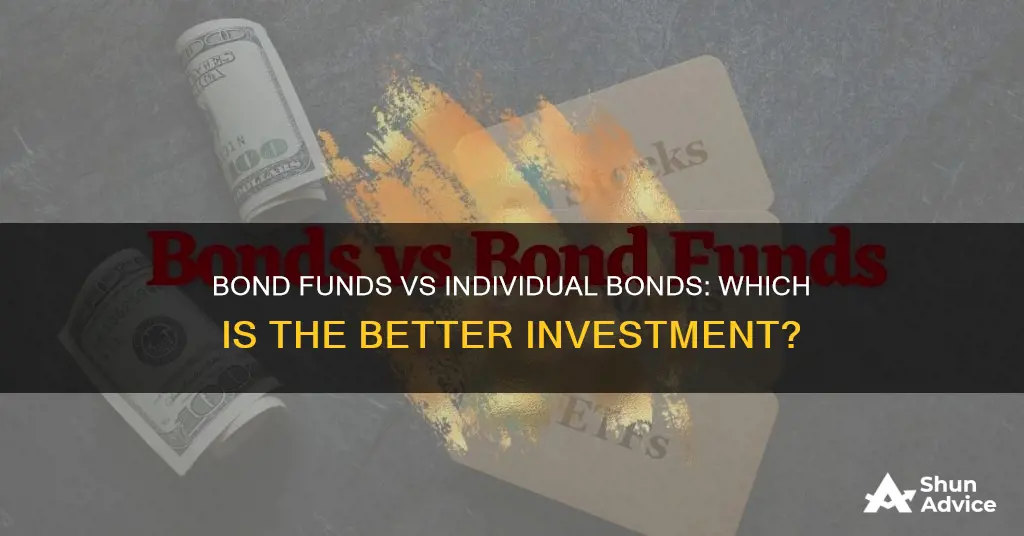
Investing in bonds can be a great way to generate income and reduce risk and volatility in your portfolio. But how do you decide between investing in bond funds or individual bonds?
There are several factors to consider when making this decision, including your investment goals, risk tolerance, and time horizon. Here are some key differences between the two options to help you make an informed choice:
Investment Management
With individual bonds, you are responsible for researching and selecting specific bonds that align with your goals. This requires a strong understanding of the bond market and the ability to monitor market trends. Bond funds, on the other hand, are managed by professional fund managers who handle the task of bond selection and trading.
Research and Oversight
Investing in individual bonds demands thorough research into the bond issuer and market trends. Bond funds, however, alleviate this burden by conducting extensive research and analysis on the issuers of the bonds they hold.
Interest Rate Impact
Both individual bonds and bond funds are affected by interest rate changes. When interest rates rise, the value of existing bonds generally falls. Bond funds can mitigate this impact through diversification, as they hold a variety of bonds with different maturities.
Cost and Accessibility
Individual bonds typically have high minimum investment requirements, which can limit accessibility for smaller investors. Bond funds, on the other hand, often have lower minimum investment amounts and benefit from economies of scale, resulting in lower costs for investors.
Liquidity
The bond market is generally less liquid than the stock market, making it challenging to sell individual bonds before maturity. Bond funds, however, offer the same level of liquidity as stocks, allowing investors to buy and sell shares on any trading day.
Ultimately, the decision between investing in bond funds or individual bonds depends on your specific circumstances and goals. Bond funds may be more suitable for those seeking diversification, professional management, and easier liquidity. Individual bonds may be a better option for investors with a long-term horizon, higher risk tolerance, and the desire to actively manage their investments.
| Characteristics | Individual Bonds | Bond Funds |
|---|---|---|
| Control and Transparency | High | Low |
| Research and Oversight | High | Low |
| Predictability | High | Medium |
| Management Fees | None | High |
| Frequency of Income | Twice a year | Monthly |
| Cost | High | Low |
| Diversification | Low | High |
| Liquidity | Low | High |
| Return Predictability | High | Low |
| Principal Protection | High | Low |
| Level of Control and Transparency | High | Low |
| Research and Oversight | High | Low |
| Tax Efficiency | High | Low |

Control and transparency
Investing in individual bonds gives you greater control over your portfolio. You can decide what to buy, and whether to hold those bonds until maturity or sell them before they mature. You can also better plan and control your income stream, as you know the maturity and coupon payment dates of the bonds you own. You can also access the exact details of what you own at any time.
However, this control comes with the responsibility of managing your portfolio. Buying individual bonds demands a big time commitment and a strong understanding of the bond market. You will need to conduct thorough research into the issuer and market trends, which can be time-consuming and requires a good understanding of fixed-income investing.
With bond funds, you have control over what fund you invest in, but once you're invested, you don't have control over exactly what the fund holds. Funds have stated objectives, and guardrails around what they may invest in, but within those limits, it's up to the fund manager to decide what to invest in.
Transparency
With individual bonds, you have total transparency over what you own (within the limits of what's available in the marketplace).
Bond funds, on the other hand, have to publish their complete holdings periodically, and these are often only available a few times a year, and with a lag. ETFs generally offer greater transparency than mutual funds, with many ETFs disclosing their complete holdings daily.
If you want full control and transparency over your investments, individual bonds may be the right choice. However, this comes with a significant time commitment and the need for a strong understanding of the bond market.
If you're willing to sacrifice some control and transparency for an easier, more hands-off investment, then bond funds could be a better option. You will still have control over what fund you invest in, but you won't have to worry about managing your portfolio day-to-day.
Choosing the Right Investment Fund: A Comprehensive Guide
You may want to see also

Research and oversight
- Time and Expertise: Investing in individual bonds requires significant time and expertise in fixed-income investing. You need to conduct thorough research into the bond issuer and market trends, and continuously monitor your portfolio to make informed decisions. This do-it-yourself approach can be rewarding if you have the time and enjoy the research process, but it demands a strong understanding of the bond market. Bond funds, on the other hand, offer professional management, delegating investment decisions to experts who conduct extensive research and analysis.
- Information Availability: While a wealth of information is available online to aid your research for individual bonds, bond funds provide more transparency by disclosing their complete holdings periodically. Many bond ETFs disclose their holdings daily, while mutual funds often publish their holdings a few times a year. This increased transparency allows you to closely monitor the fund's investment strategy and alignment with your goals.
- Alignment with Goals: Individual bonds offer greater flexibility in repositioning your portfolio based on market conditions and interest rates. You can invest in individual bonds based on your risk appetite, duration preference, and desired rate of return. Bond funds, on the other hand, have stated objectives and guardrails that fund managers must follow, giving you less control over the specific bonds in your portfolio.
- Tax Implications: Individual bonds offer better oversight of tax implications since their defined coupon rates, face values, and maturity dates make it easier to predict costs and returns. Bond funds, on the other hand, may have hidden tax consequences due to capital gains distributions, making tax planning more challenging.
- Reinvestment of Interest: With individual bonds, you need to actively manage the reinvestment of interest and principal after maturity. Bond funds, on the other hand, offer automatic dividend reinvestment options, making it more convenient to manage your portfolio.
Derivatives: A Mutual Fund's Strategic Investment Choice
You may want to see also

Liquidity
Individual bonds are generally considered to have lower liquidity than bond funds. This is because individual bonds are often traded over the counter, meaning investors must use a broker, and the bond market is less liquid than the stock market. As a result, it may take time to find a buyer for your bond at a fair price.
On the other hand, bond funds offer the same liquidity as stocks, allowing investors to buy and sell shares on any trading day. Bond mutual funds offer daily liquidity, with trades typically executing on the next trading day after the market closes. Bond ETFs take this a step further by offering intraday liquidity, allowing investors to buy and sell shares on the exchange in real-time.
The higher liquidity of bond funds means that investors can access their money more easily and quickly. However, it's important to note that selling a bond fund investment may result in a capital gain or loss.
In terms of accessibility, bond funds also typically have lower minimum investment requirements than individual bonds, making them more accessible to smaller retail investors.
While individual bonds may have high minimum investment requirements, sometimes reaching into the thousands of dollars, bond funds often have lower minimums, with bond ETFs usually having no minimum investment requirements.
Additionally, bond funds benefit from economies of scale, allowing them to negotiate better prices on bond purchases, which can result in lower costs for investors.
Overall, bond funds offer greater liquidity and accessibility than individual bonds, making it easier for investors to buy, sell, and access their investments.
Mutual Fund or Index Fund: Where Should You Invest?
You may want to see also

Diversification
On the other hand, achieving broad diversification with individual bonds can be more cumbersome and expensive. Individual bonds require investing in multiple bonds and laddering them to ensure the availability of funds at different times and to minimize concentration. The higher cost of individual bonds means that investors need to allocate more capital to achieve a diversified portfolio.
Bond funds offer a convenient, cost-effective way to achieve diversification, especially for small retail investors. However, it's important to note that bond funds may have higher expense ratios, which can eat into returns, especially during periods of low interest rates.
Additionally, while bond funds provide diversification within the fund itself, individual bonds allow investors to further diversify their overall portfolio by combining different types of bonds, such as government, municipal, and corporate bonds. This type of diversification is particularly important for bonds, as the default of a single bond could have a significant impact on the portfolio.
In summary, bond funds excel in providing intrafund diversification, making them a good choice for investors seeking a simple, cost-effective way to invest in bonds. Individual bonds, while more expensive and time-consuming to manage, offer the advantage of enabling further diversification across different types of bonds.
Vanguard Funds: Exploring India-Centric Investment Opportunities
You may want to see also

Costs
There are a variety of costs associated with investing in individual bonds or bond funds. When it comes to individual bonds, investors typically need to purchase them through a brokerage account. While it is possible to buy bonds directly from the issuer, this option is often limited to large institutional investors. The cost of individual bonds is generally higher than that of bond funds, making them prohibitively expensive for retail investors at times.
Additionally, individual bonds usually have high minimum investment requirements, sometimes reaching into the thousands of dollars. This can limit accessibility for smaller investors. The cost of diversifying a bond portfolio by investing in multiple bonds can also be high, as investors need to allocate more capital to bonds to achieve a diversified portfolio.
On the other hand, bond funds offer greater accessibility and lower costs. They often have lower minimum investment requirements, and by pooling money from multiple investors, they can negotiate better prices for bond purchases. As a result, investors in bond funds often pay lower costs. Bond funds that are exchange-traded funds (ETFs) typically have lower expense ratios than mutual funds, making them a more cost-effective option.
However, one potential drawback of bond funds is their expense ratios. These fees, charged by the fund manager, can significantly reduce the interest income generated by the underlying bonds. This can be especially impactful during periods of low-interest rates, when a modest yield can be diminished by high fees.
When deciding between individual bonds and bond funds, investors should carefully consider the costs associated with each option. While individual bonds may have higher upfront costs and minimum investment requirements, bond funds may have higher ongoing costs in the form of expense ratios.
Balance Sheet Basics: Displaying Mutual Fund Investments
You may want to see also
Frequently asked questions
The benefits of investing in individual bonds include control and transparency, predictability, and no additional expenses.
The drawbacks of investing in individual bonds include a lower frequency of income, high costs, and the challenge of achieving diversification.
The benefits of investing in bond funds include consistent income, cost-effectiveness and accessibility, liquidity, and diversification for a lower cost.







